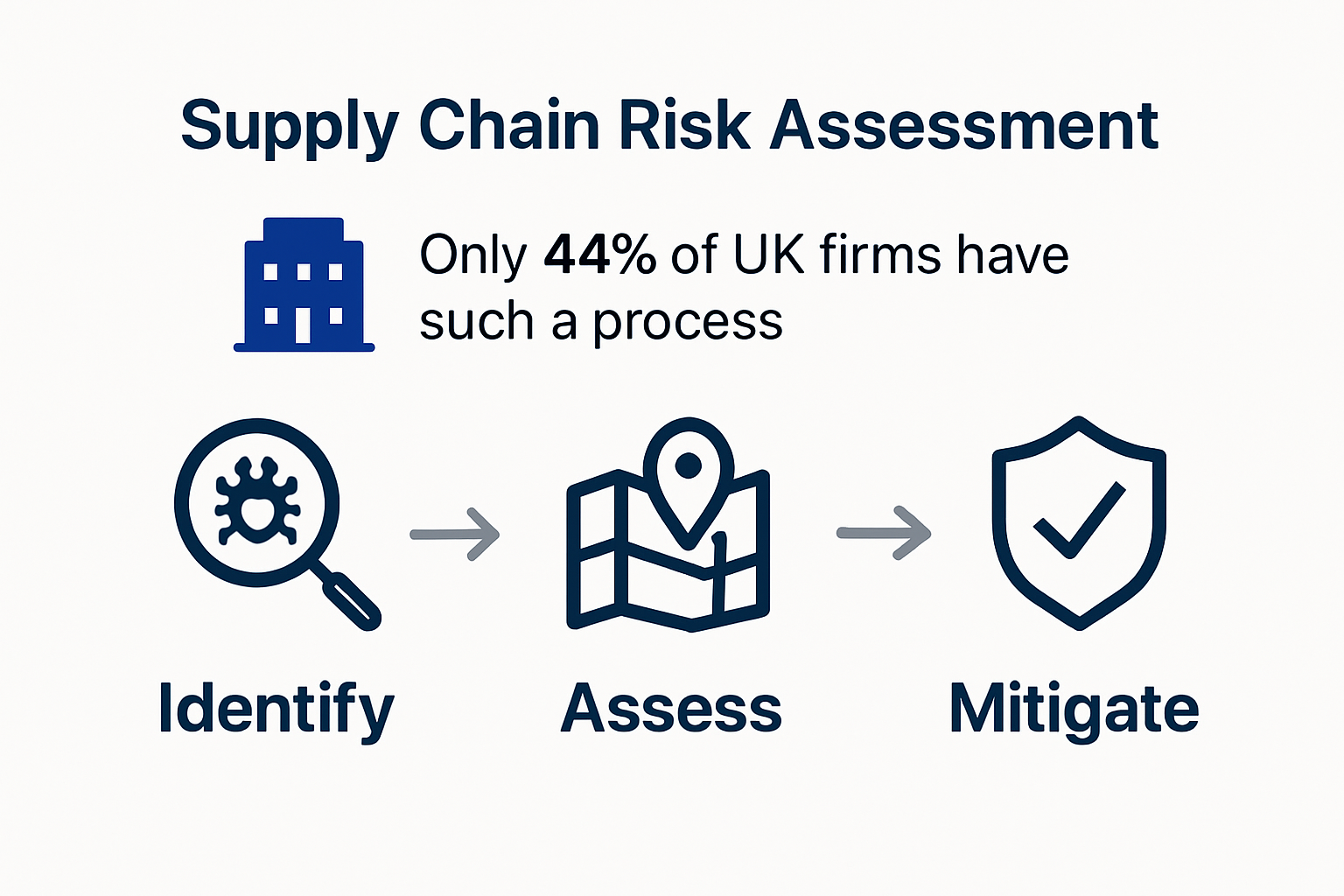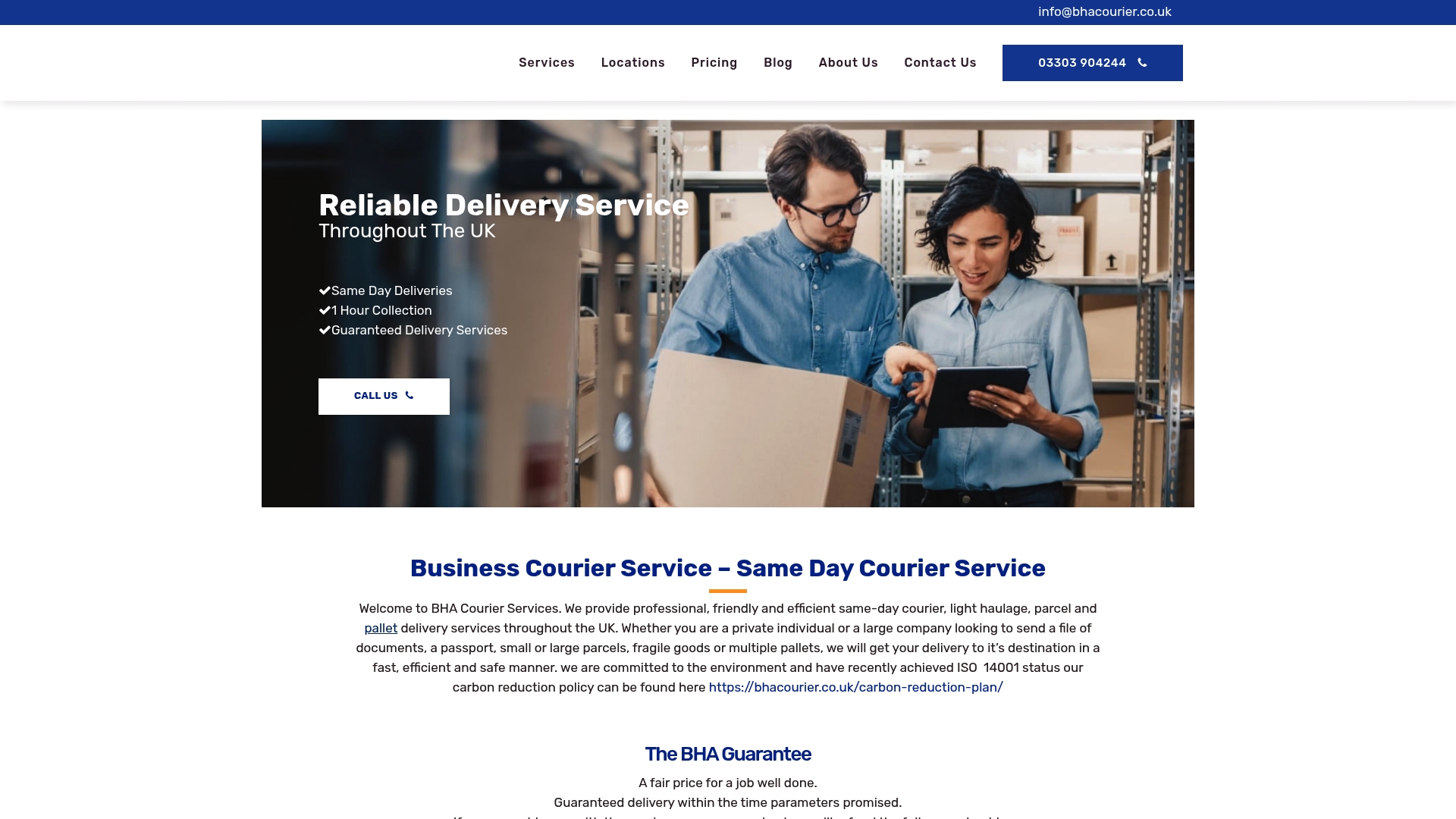
16 Aug Supply Chain Risk Assessment Guide for UK Businesses
Supply chain disruption is now a real threat for every UK business and even short interruptions can wipe out profits in a matter of days. Yet despite this, only 44 percent of UK firms have a documented risk management process for their supply chain. Most assume that preparing for obvious threats is enough. The surprising reality is that the biggest risks are the ones nobody sees coming, and those can only be tackled with a thorough, proactive assessment that most companies still neglect.
Table of Contents
- Understanding Supply Chain Risk Assessment Basics
- Key Risks Faced By UK Businesses Today
- Practical Steps To Assess And Manage Risks
- Supply Chain Risk Assessment Tools And Templates
Quick Summary
| Takeaway | Explanation |
|---|---|
| Assess Supply Chain Vulnerabilities | Identify potential weaknesses in suppliers, technology, and logistics to enhance overall stability. |
| Implement Proactive Management Strategies | Develop flexible frameworks for continuous monitoring and quick adaptation to emerging risks. |
| Map Interconnected Supply Chains | Create visual representations to identify dependencies and critical points of vulnerability. |
| Utilise Advanced Tools for Risk Assessment | Leverage technology like AI and predictive analytics to effectively gauge and respond to risks. |
| Adapt to Environmental Changes | Foster resilient strategies to quickly handle climate and health-related disruptions preparedness. |
Understanding Supply Chain Risk Assessment Basics
Supply chain risk assessment represents a critical strategic process for UK businesses seeking to protect their operational integrity and financial stability. At its core, this systematic approach enables organisations to identify, analyse, and mitigate potential disruptions that could compromise their supply chain performance.
The Fundamental Framework of Supply Chain Risk Assessment
A comprehensive supply chain risk assessment involves methodically examining potential vulnerabilities across an organisation’s entire procurement and logistics ecosystem. According to the National Institute of Standards and Technology, this process requires businesses to systematically evaluate risks, their potential likelihood, and potential impacts on organisational operations.
The assessment typically encompasses multiple dimensions of risk, including:
- Supplier Reliability: Evaluating the financial stability, operational capacity, and historical performance of key suppliers
- Geopolitical Risks: Analysing potential disruptions from international trade tensions, regulatory changes, or regional instabilities
- Technological Vulnerabilities: Identifying potential cybersecurity threats or technological infrastructure weaknesses
Strategic Risk Identification and Mapping
Effective supply chain risk assessment goes beyond merely identifying potential problems. Research from NIST emphasises the importance of creating comprehensive supply chain maps that visually represent interconnected relationships and potential points of vulnerability.
This mapping process allows businesses to:
- Trace product and information flows
- Identify critical dependencies
- Develop targeted mitigation strategies
Businesses can leverage these insights to create robust contingency plans that minimise potential disruptions. For organisations looking to enhance their risk management approach, our guide on logistics risk strategies provides additional strategic insights for UK enterprises.
Implementing a Proactive Risk Management Approach
Successful supply chain risk assessment requires a proactive and dynamic approach. UK businesses must develop flexible frameworks that can quickly adapt to changing economic, technological, and geopolitical landscapes. This involves continuous monitoring, regular reassessment, and a willingness to modify strategies based on emerging insights.
Key elements of a proactive risk management approach include:
- Regular supplier performance evaluations
- Diversification of supply sources
- Investment in real-time monitoring technologies
- Development of agile response protocols
By embracing a comprehensive and strategic approach to supply chain risk assessment, UK businesses can transform potential vulnerabilities into opportunities for resilience and competitive advantage. The goal is not to eliminate all risks but to develop the organisational capability to anticipate, respond, and adapt to complex and evolving challenges.
Modern supply chain risk management is less about prediction and more about preparedness. It requires a holistic view that integrates technological insights, strategic planning, and organisational flexibility.
Key Risks Faced by UK Businesses Today
The contemporary business landscape presents UK enterprises with an increasingly complex and volatile environment, characterised by multifaceted risks that can significantly impact supply chain performance and organisational resilience. Understanding these challenges is crucial for developing effective risk mitigation strategies.
Economic and Geopolitical Disruption Risks
UK businesses currently face unprecedented economic uncertainties driven by global market fluctuations, trade policy changes, and geopolitical tensions. Research from McKinsey Global Institute highlights that advanced economies like the UK are particularly vulnerable to supply chain shocks from various external factors.
Key economic and geopolitical risks include:
- Brexit Implications: Continuing regulatory uncertainties and potential trade barriers
- International Trade Tensions: Potential disruptions from global economic conflicts
- Currency Volatility: Exchange rate fluctuations impacting procurement costs
Technological and Operational Vulnerability Risks
The rapid digital transformation has introduced sophisticated technological risks that can compromise supply chain integrity. Cybersecurity threats, technological infrastructure failures, and data breaches represent significant challenges for modern UK businesses.
Critical technological risk areas encompass:
- Cybersecurity vulnerabilities
- Data protection and privacy challenges
- Technological infrastructure disruptions
- Artificial intelligence and automation integration risks
For businesses seeking comprehensive strategies to address these challenges, our logistics risk management guide provides detailed insights into navigating complex operational environments.
Environmental and Pandemic-Related Supply Chain Risks
The increasing frequency of global environmental challenges and health crises has dramatically transformed risk management approaches. Climate change, extreme weather events, and pandemic-related disruptions have exposed significant vulnerabilities in traditional supply chain models.
Environmental and health-related risks include:
- Climate change impact on logistics and transportation
- Resource scarcity and sustainability challenges
- Potential future pandemic-related supply chain disruptions
- Regulatory shifts towards environmental compliance
Businesses must adopt agile, resilient strategies that can rapidly adapt to unpredictable global conditions. This requires continuous monitoring, scenario planning, and investment in flexible technological infrastructure.
The modern UK business landscape demands a proactive and holistic approach to risk management. Success depends not just on identifying potential challenges but developing robust, adaptive systems that can transform risks into opportunities for innovation and competitive advantage.
Effective risk management is no longer about prevention but about building organisational resilience and maintaining operational continuity in an increasingly uncertain global environment.
To help readers quickly compare the primary categories of supply chain risks faced by UK businesses today, the following table summarises the main risk types and highlights representative examples mentioned in the article.
| Risk Category | Description | Example Risks |
|---|---|---|
| Economic & Geopolitical Disruption | Uncertainties due to market changes, policies, and global events | Brexit implications, trade tensions, currency volatility |
| Technological & Operational Vulnerability | Risks from digital transformation or operational systems | Cybersecurity, infrastructure failures, AI integration |
| Environmental & Pandemic-Related | Risks linked to climate or global health events | Climate change, extreme weather, pandemic disruption |
Practical Steps to Assess and Manage Risks
Navigating supply chain risks requires a structured and strategic approach that empowers UK businesses to proactively identify, evaluate, and mitigate potential disruptions. Developing a comprehensive risk management framework is essential for maintaining operational resilience and competitive advantage.
Systematic Risk Identification and Documentation
According to the National Institute of Standards and Technology, effective risk management begins with thorough documentation and systematic identification of potential vulnerabilities. This process involves creating a detailed inventory of all supply chain components, mapping interdependencies, and establishing a comprehensive risk register.
Key components of systematic risk identification include:

- Comprehensive Asset Mapping: Documenting all critical supply chain assets, including suppliers, technologies, and logistical infrastructure
- Stakeholder Consultation: Engaging with internal teams and external partners to gather diverse perspectives on potential risks
- Historical Data Analysis: Reviewing past incidents and near-misses to identify recurring vulnerability patterns
Risk Assessment and Prioritisation Strategies
Once risks are identified, businesses must develop a robust methodology for assessing and prioritising potential threats. This involves evaluating each risk based on its likelihood of occurrence and potential impact on organisational operations.
Effective risk assessment techniques include:
- Quantitative risk scoring models
- Scenario planning and simulation exercises
- Impact and probability matrix development
For organisations seeking more detailed guidance on implementing these strategies, our logistics risk management resources provide comprehensive insights into advanced risk assessment techniques.
Developing Adaptive Mitigation and Response Protocols
Risk management is not a static process but a dynamic, continuous approach that requires flexible response mechanisms. Businesses must develop adaptive mitigation strategies that can quickly respond to emerging challenges and changing environmental conditions.
Critical elements of effective risk mitigation include:
- Developing comprehensive contingency plans
- Creating redundant supply chain pathways
- Implementing real-time monitoring systems
- Establishing clear communication protocols for rapid response
Successful risk management transcends mere prevention. It represents a strategic approach to transforming potential vulnerabilities into opportunities for innovation and organisational resilience. By adopting a proactive, systematic methodology, UK businesses can build supply chains that are not just robust, but genuinely adaptive and future-ready.

The ultimate goal is not to eliminate all risks but to develop organisational capabilities that can anticipate, respond, and thrive in an increasingly complex and unpredictable business environment. This requires continuous learning, investment in technological capabilities, and a culture of strategic agility.
Supply Chain Risk Assessment Tools and Templates
Modern UK businesses require sophisticated yet accessible tools and templates to effectively navigate the complex landscape of supply chain risk management. Selecting the right assessment instruments can dramatically improve an organisation’s ability to identify, analyse, and mitigate potential disruptions.
Comprehensive Risk Assessment Framework Tools
According to the National Institute of Standards and Technology, developing a robust risk assessment framework requires strategic tools that enable systematic documentation and evaluation of potential vulnerabilities.
Key tools for comprehensive risk assessment include:
- Quantitative Risk Scoring Matrices: Enabling objective measurement of risk likelihood and potential impact
- Supply Chain Mapping Software: Visualising complex interdependencies and potential vulnerability points
- Scenario Simulation Platforms: Creating predictive models of potential disruption scenarios
These tools provide businesses with structured approaches to transform abstract risk concepts into tangible, actionable insights.
Digital Risk Assessment Templates and Checklists
Effective risk management demands standardised yet flexible documentation mechanisms. Digital templates offer organisations a repeatable methodology for capturing critical risk information consistently across different supply chain segments.
Essential template components typically include:
- Supplier risk profile documentation
- Vulnerability identification worksheets
- Risk mitigation action planning documents
- Incident response communication protocols
For businesses seeking additional guidance on implementing these tools, our logistics risk management strategies provide comprehensive insights into practical risk assessment approaches.
Technology-Enabled Risk Monitoring Solutions
Advanced technological solutions are transforming supply chain risk assessment from a reactive to a predictive discipline. Modern businesses can leverage artificial intelligence, machine learning, and real-time data analytics to develop more sophisticated risk management capabilities.
Cutting-edge risk monitoring technologies include:
- Automated supplier performance tracking systems
- Predictive analytics platforms
- Cybersecurity risk detection tools
- Global event monitoring dashboards
Successful implementation of these tools requires more than technological investment. It demands a cultural shift towards data-driven decision making and continuous risk awareness.
The most effective supply chain risk assessment approaches integrate human expertise with technological capabilities. While tools provide critical insights, organisational agility, strategic thinking, and adaptive management remain paramount.
Businesses must view risk assessment tools not as static solutions but as dynamic instruments that evolve alongside increasingly complex global supply chain ecosystems. Continuous learning, regular tool recalibration, and a commitment to technological innovation are essential for maintaining robust risk management capabilities.
The following table outlines key tools and templates for supply chain risk assessment as referenced in the article, summarising their main purposes to guide UK businesses in selecting appropriate support for their risk management needs.
| Tool/Template Type | Main Purpose | Examples/Focus |
|---|---|---|
| Quantitative Risk Scoring Matrices | Objectively assess risk likelihood and potential impact | Scoring models, impact-probability matrices |
| Supply Chain Mapping Software | Visualise interdependencies and vulnerabilities | Mapping software, asset visualisation |
| Scenario Simulation Platforms | Model potential disruption scenarios | Simulation, scenario planning |
| Digital Risk Templates & Checklists | Standardise capture of risk information | Supplier profiles, action planning sheets |
| Technology-Enabled Monitoring | Real-time predictive analytics for risks | AI, dashboards, cybersecurity tools |
Frequently Asked Questions
What is a supply chain risk assessment?
A supply chain risk assessment is a systematic process that helps businesses identify, analyse, and mitigate potential disruptions in their supply chains, ensuring operational integrity and financial stability.
Why is it important for UK businesses to conduct supply chain risk assessments?
Conducting supply chain risk assessments is crucial for UK businesses to protect against unforeseen disruptions, maintain operational continuity, and gain a competitive advantage in an increasingly complex business environment.
What are some common risks faced by UK businesses in their supply chains?
Common risks include economic and geopolitical disruptions, technological vulnerabilities, and environmental or pandemic-related challenges that can adversely affect supply chain performance.
How can businesses implement proactive risk management strategies?
Businesses can implement proactive risk management strategies by regularly evaluating supplier performance, diversifying supply sources, employing real-time monitoring technologies, and creating agile response protocols to adapt to emerging risks.
Turn Supply Chain Uncertainty Into Reliable Delivery
Feeling exposed by unexpected supply chain risks? As highlighted in our guide, a single disruption to your logistics process can undermine all your risk assessments and contingency plans. You need a delivery partner that shares your commitment to reliability, rapid response and total visibility – not just during calm periods, but when every hour counts. With unpredictable events, missed deadlines, and operational bottlenecks threatening your competitive edge, it is time to move from risk planning to risk control.

BHA Courier’s time-critical courier services are a proven way to remove the guesswork from your supply chain. Secure urgent document shipments, same-day parcel collection, or safe delivery for fragile goods across the UK, all fully tracked from collection to destination. Our ISO 14001 certification and trusted network give your business the continuity and confidence you need. Make the switch today: visit BHA Courier, or explore our full range of services to experience seamless logistics support that never leaves your business vulnerable. The risks will not wait. Neither should you.
Recommended
- Risk Management in Logistics: Essential Strategies for UK Businesses 2025 – BHA Couriers
- Streamlining Supply Chain in the UK: Expert Tips for 2025 – BHA Couriers
- Shipping Hazardous Materials in the UK: 2025 Guide for Businesses – BHA Couriers
- Best Business Sustainability Practices for UK Success 2025 – BHA Couriers

Sorry, the comment form is closed at this time.